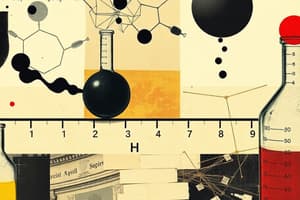Podcast
Questions and Answers
What is an ionic compound that can form from the reaction of an acid with a base?
What is an ionic compound that can form from the reaction of an acid with a base?
Salt
What is the reaction between an acid and a base called?
What is the reaction between an acid and a base called?
Neutralization
What is the series of numbers that indicates the concentration of hydrogen ions in solution?
What is the series of numbers that indicates the concentration of hydrogen ions in solution?
pH scale
What is represented by the symbol H+?
What is represented by the symbol H+?
What is represented by the symbol OH-?
What is represented by the symbol OH-?
Substances with a pH of 0-6 are what?
Substances with a pH of 0-6 are what?
Substances with a pH of 8-14 are what?
Substances with a pH of 8-14 are what?
Substances with a pH of 0-6 form what in water?
Substances with a pH of 0-6 form what in water?
Substances with a pH of 8-14 form what in water?
Substances with a pH of 8-14 form what in water?
When found in foods, acids taste like what?
When found in foods, acids taste like what?
What do bases taste like in food?
What do bases taste like in food?
What color do acids turn litmus?
What color do acids turn litmus?
What color does a base turn litmus?
What color does a base turn litmus?
How does acid react with the metals magnesium, zinc, and iron?
How does acid react with the metals magnesium, zinc, and iron?
How do bases react with the metals magnesium, zinc, and iron?
How do bases react with the metals magnesium, zinc, and iron?
How do acids react with carbonates?
How do acids react with carbonates?
How do bases react with carbonates?
How do bases react with carbonates?
What is a compound that changes color when in contact with an acid or a base?
What is a compound that changes color when in contact with an acid or a base?
Study Notes
General Concepts of Acids and Bases
- Salt is the ionic compound formed from the reaction of an acid with a base.
- Neutralization refers to the chemical reaction between an acid and a base, typically resulting in water and a salt.
pH and Ion Concentration
- The pH scale measures the concentration of hydrogen ions (H+) in a solution, indicating its acidity or basicity.
- Acids, characterized by a pH ranging from 0 to 6, increase hydrogen ion concentration in water.
- Bases, with a pH ranging from 8 to 14, produce hydroxide ions (OH-) in water.
Taste and Indicators
- Acids in food commonly have a sour taste, while bases often taste bitter.
- Litmus paper is used as an indicator, turning red in acidic solutions and blue in basic solutions.
Reactions with Metals and Carbonates
- Acids can cause corrosion when they react with metals such as magnesium, zinc, and iron.
- Bases do not react with these metals, remaining inert.
- When acids interact with carbonates, they produce carbon dioxide (CO2), while bases do not exhibit a reaction with carbonates.
Indicators
- An indicator is a compound that changes color when it comes into contact with an acid or a base, helping to identify the solution's pH.
Studying That Suits You
Use AI to generate personalized quizzes and flashcards to suit your learning preferences.
Description
Explore the fundamental concepts of acids and bases, including their properties, pH scale, and reactions. This quiz will test your understanding of acids' and bases' characteristics, including their tastes, indicators, and interactions with metals and carbonates.



